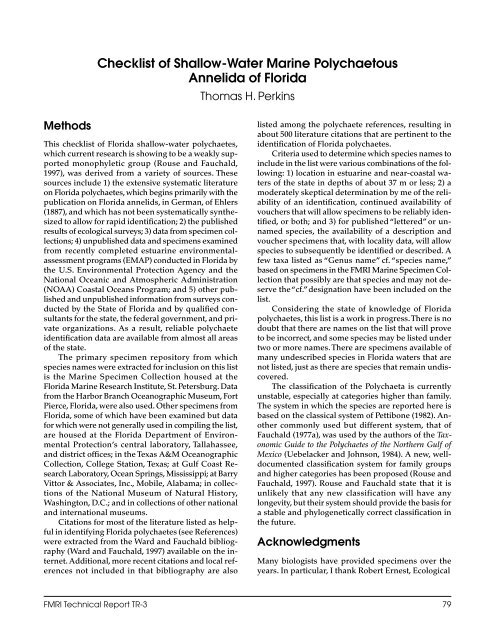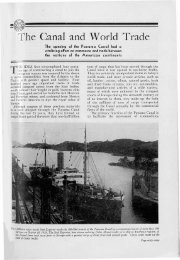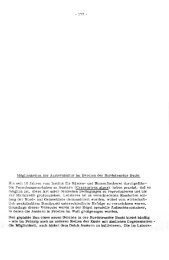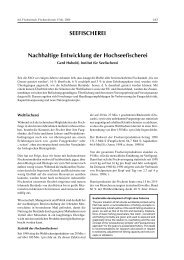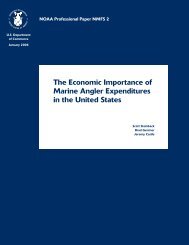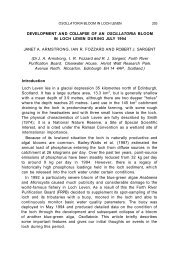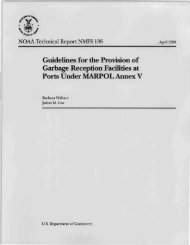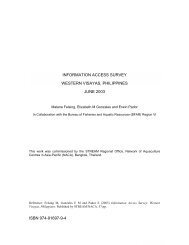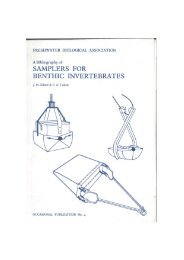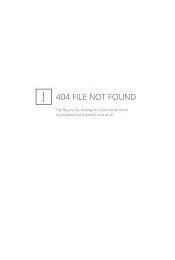Download - Aquatic Commons
Download - Aquatic Commons
Download - Aquatic Commons
You also want an ePaper? Increase the reach of your titles
YUMPU automatically turns print PDFs into web optimized ePapers that Google loves.
Methods<br />
Checklist of Shallow-Water Marine Polychaetous<br />
Annelida of Florida<br />
Thomas H. Perkins<br />
This checklist of Florida shallow-water polychaetes,<br />
which current research is showing to be a weakly supported<br />
monophyletic group (Rouse and Fauchald,<br />
1997), was derived from a variety of sources. These<br />
sources include 1) the extensive systematic literature<br />
on Florida polychaetes, which begins primarily with the<br />
publication on Florida annelids, in German, of Ehlers<br />
(1887), and which has not been systematically synthesized<br />
to allow for rapid identification; 2) the published<br />
results of ecological surveys; 3) data from specimen collections;<br />
4) unpublished data and specimens examined<br />
from recently completed estuarine environmentalassessment<br />
programs (EMAP) conducted in Florida by<br />
the U.S. Environmental Protection Agency and the<br />
National Oceanic and Atmospheric Administration<br />
(NOAA) Coastal Oceans Program; and 5) other published<br />
and unpublished information from surveys conducted<br />
by the State of Florida and by qualified consultants<br />
for the state, the federal government, and private<br />
organizations. As a result, reliable polychaete<br />
identification data are available from almost all areas<br />
of the state.<br />
The primary specimen repository from which<br />
species names were extracted for inclusion on this list<br />
is the Marine Specimen Collection housed at the<br />
Florida Marine Research Institute, St. Petersburg. Data<br />
from the Harbor Branch Oceanographic Museum, Fort<br />
Pierce, Florida, were also used. Other specimens from<br />
Florida, some of which have been examined but data<br />
for which were not generally used in compiling the list,<br />
are housed at the Florida Department of Environmental<br />
Protection’s central laboratory, Tallahassee,<br />
and district offices; in the Texas A&M Oceanographic<br />
Collection, College Station, Texas; at Gulf Coast Research<br />
Laboratory, Ocean Springs, Mississippi; at Barry<br />
Vittor & Associates, Inc., Mobile, Alabama; in collections<br />
of the National Museum of Natural History,<br />
Washington, D.C.; and in collections of other national<br />
and international museums.<br />
Citations for most of the literature listed as helpful<br />
in identifying Florida polychaetes (see References)<br />
were extracted from the Ward and Fauchald bibliography<br />
(Ward and Fauchald, 1997) available on the internet.<br />
Additional, more recent citations and local references<br />
not included in that bibliography are also<br />
listed among the polychaete references, resulting in<br />
about 500 literature citations that are pertinent to the<br />
identification of Florida polychaetes.<br />
Criteria used to determine which species names to<br />
include in the list were various combinations of the following:<br />
1) location in estuarine and near-coastal waters<br />
of the state in depths of about 37 m or less; 2) a<br />
moderately skeptical determination by me of the reliability<br />
of an identification, continued availability of<br />
vouchers that will allow specimens to be reliably identified,<br />
or both; and 3) for published “lettered” or unnamed<br />
species, the availability of a description and<br />
voucher specimens that, with locality data, will allow<br />
species to subsequently be identified or described. A<br />
few taxa listed as “Genus name” cf. “species name,”<br />
based on specimens in the FMRI Marine Specimen Collection<br />
that possibly are that species and may not deserve<br />
the “cf.”designation have been included on the<br />
list.<br />
Considering the state of knowledge of Florida<br />
polychaetes, this list is a work in progress.There is no<br />
doubt that there are names on the list that will prove<br />
to be incorrect, and some species may be listed under<br />
two or more names.There are specimens available of<br />
many undescribed species in Florida waters that are<br />
not listed, just as there are species that remain undiscovered.<br />
The classification of the Polychaeta is currently<br />
unstable, especially at categories higher than family.<br />
The system in which the species are reported here is<br />
based on the classical system of Pettibone (1982). Another<br />
commonly used but different system, that of<br />
Fauchald (1977a), was used by the authors of the Taxonomic<br />
Guide to the Polychaetes of the Northern Gulf of<br />
Mexico (Uebelacker and Johnson, 1984). A new, welldocumented<br />
classification system for family groups<br />
and higher categories has been proposed (Rouse and<br />
Fauchald, 1997). Rouse and Fauchald state that it is<br />
unlikely that any new classification will have any<br />
longevity, but their system should provide the basis for<br />
a stable and phylogenetically correct classification in<br />
the future.<br />
Acknowledgments<br />
Many biologists have provided specimens over the<br />
years. In particular, I thank Robert Ernest, Ecological<br />
FMRI Technical Report TR-3 79


